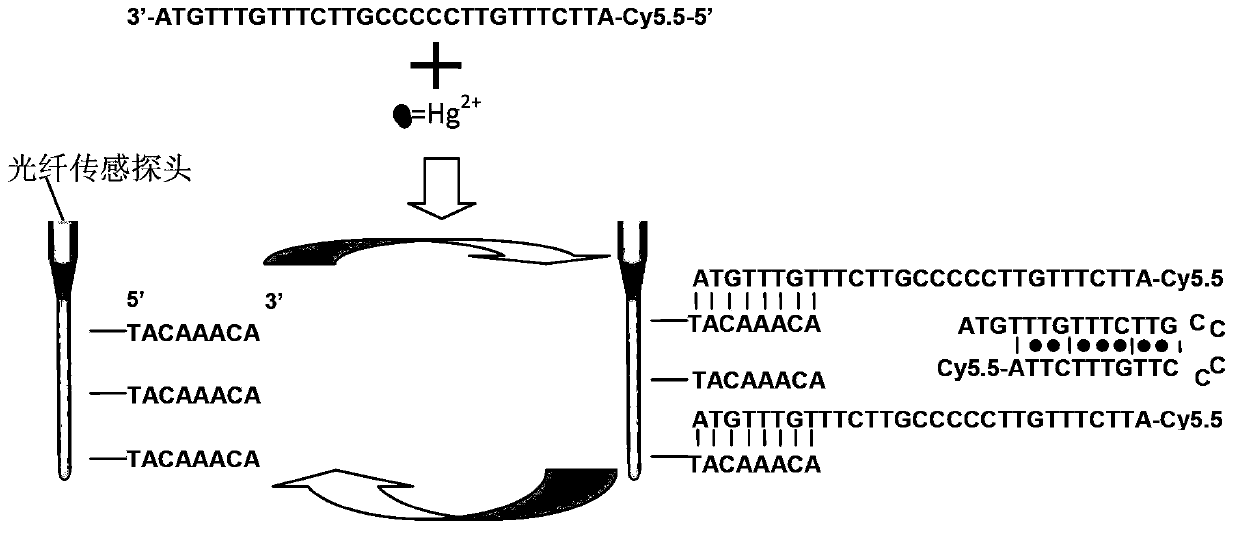Detecting method for divalent mercury ions
A DNA molecule, single-stranded technology, applied in the field of divalent mercury ion detection, can solve the problems of insufficient specificity, insufficient sensitivity, complicated design and operation, etc., and achieve good accuracy, precision, and high selectivity.
- Summary
- Abstract
- Description
- Claims
- Application Information
AI Technical Summary
Problems solved by technology
Method used
Image
Examples
Embodiment 1
[0038] Embodiment 1, immobilization of DNA capture probe
[0039] DNA Capture Probe 1: 5'-NH 2 -(CH 2 ) 6 -TACAAACA-3' (SEQ ID NO: 2);
[0040] DNA capture probe 2: 5'-NH 2 -(CH 2 ) 6 -TACAAACAAA-3' (Sequence Listing Sequence 3);
[0041] The DNA capture probes 1 and 2 are respectively modified on the evanescent wave optical fiber sensing probe according to the method comprising the following steps:
[0042] 1. Probe cleaning
[0043] Immerse the evanescent wave fiber optic sensing probe in piraha solution (concentrated H 2 SO 4 with H 2 o 2 The volume ratio of water is 3:1) for 30 minutes; then put it into an ultrasonic cleaner and wash it thoroughly with ultrapure water until the pH value of the cleaning solution is neutral, and finally dry it with nitrogen at room temperature and store in Store in a vacuum oven.
[0044] 2. Silanize the probe surface treated in step 1 according to the method comprising the following steps:
[0045] Put the probe treated in ste...
Embodiment 2
[0048] Example 2, Hg 2+ detection
[0049] 1. Hg 2+ Establishment of the Functional Relation between Concentration and Fluorescent Signal Intensity
[0050] 1. Load the evanescent wave optical fiber sensing probe whose surface is modified with the single-stranded DNA molecule A shown in Sequence 2 of the Sequence Listing obtained in Example 1 into the evanescent wave optical fiber sensing analysis platform;
[0051] 2. The known Hg 2+ The standard solution (solvent is water) with concentrations of 0, 10, 30, 100, 300 and 1000nmol / L were respectively added with the final concentration of 20nmol / L the 5' end modified by fluorescein Strand DNA molecule B is then pumped into the sample pool at 300 μL / min (the pool is equipped with an evanescent wave fiber optic sensing probe whose surface is modified with single-stranded DNA molecule A shown in sequence number 2 of the sequence listing) for 30 seconds, and further reaction 4min; the reaction principle is as follows figure 1 s...
Embodiment 3
[0060] Example 3, Hg 2+ detection
[0061] 1. Hg 2+ Establishment of the Functional Relation between Concentration and Fluorescent Signal Intensity
[0062] 1. Load the evanescent wave optical fiber sensing probe whose surface is modified with the single-stranded DNA molecule A shown in Sequence 3 of the Sequence Listing obtained in Example 1 into the evanescent wave optical fiber sensing analysis platform;
[0063] 2. The known Hg 2+ The standard solution (solvent is water) with concentrations of 0, 10, 30, 100, 300 and 1000nmol / L were respectively added with the final concentration of 20nmol / L the 5' end modified by fluorescein Strand DNA molecule B is then pumped into the sample pool at 300 μL / min (the pool is equipped with an evanescent wave optical fiber sensor probe whose surface is modified with single-stranded DNA molecule A shown in sequence 3 of the sequence listing), and the time is 30s, and further reaction 4min;
[0064] 3. Same as 3 in step 1 in embodiment 2...
PUM
 Login to View More
Login to View More Abstract
Description
Claims
Application Information
 Login to View More
Login to View More - R&D
- Intellectual Property
- Life Sciences
- Materials
- Tech Scout
- Unparalleled Data Quality
- Higher Quality Content
- 60% Fewer Hallucinations
Browse by: Latest US Patents, China's latest patents, Technical Efficacy Thesaurus, Application Domain, Technology Topic, Popular Technical Reports.
© 2025 PatSnap. All rights reserved.Legal|Privacy policy|Modern Slavery Act Transparency Statement|Sitemap|About US| Contact US: help@patsnap.com


